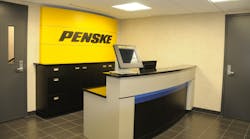Interested in working with an outside service provider? A mobile device management company can help assess a shop’s needs, suggest and manage the deployment of these devices, and assist with after-sales support.
According to VMware group product marketing manager, unified endpoint management (UEM) team Aditya Kunduri, an initial analysis can provide a baseline for approaching how to manage mobile devices in the shop. The first step is to identify the priority use case. In other words, “What are the business problems you are trying to solve that will maximize your ROI?” says Kunduri. Figure out the challenges currently faced by the operation.
“When you’re looking at specific use cases, I would highly encourage the [IT department] also look at use cases beyond just enabling … maintenance shop workers, and think through how they can provide a holistic solution that spans their IT requirements across the corporate office and other use cases as well,” suggests Kunduri.
Deryk Powell, president of Velociti, offers some additional steps for assessing and implementing a mobile device management program for a fleet operation.
Velociti is a technology design, deployment, and support company. The company’s team of employees and partner technicians utilize a Velociti-proprietary application on more than 400 mobile devices.
Planning and assessment
- Analysis of business operations, end-user functions needed, and analysis of overall device and application requirements
- Contract start date and proposed length
- Quantity of devices needed
- Deployment start and completion timeline
- Device make and model requested
- Accessories needed for specific use cases
- Connectivity capabilities – should the device have cellular and/or Wi-Fi functionality? If cellular, which data carrier is preferred and if known, what data package is required?
- Solution design. What types of apps, profile designs, customizations, etc. should be included?
- Does client have a current mobile device management (MDM) platform/license it wishes to utilize?
- If yes, what is the current client MDM platform?
- If no, is a specific MDM platform preferred, or would client like recommendations? Some platform options include Soti, VMware, Mobile Iron, Maas360.
- Does the fleet prefer to manage the MDM lifecycle services in-house, or do they prefer it to be included in the provider offering? Some of these management tasks include:
- Environment assessment/tune-up
- Set up and configuration
- Administration
- Security
- Change management
- Support
- Does the fleet require a 24/7 technical support help desk? If so, who will perform as Tier 1 support (e.g. taking calls from technicians or primary device users), and Tier 2 support (e.g. escalated calls from in-house IT support)?
Other considerations
- Map out device application and infrastructure requirements. According to VMware’s Kunduri, after identifying the use cases, determine what will help support different workloads. Consider the following questions:
- Do I need specialized or multiple OEM device vendors that need to be supported as part of this initiative?
- Do I need to support multiple application types?
- Do I need the public applications that are available in the marketplace or through independent software vendors (ISVs)? Or do I need to build my own applications using software development kits (SDKs), which I need to protect?
- Do I have contract employees? Contract employees might also be bringing their own devices, which may need to be secure.
- Think about infrastructure support needs. “We often see that customers will also need to think through the architecture or infrastructure that they need to support,” explains Kunduri. Consider some of the following:
- Is this multi-tethered cloud architecture, where I'm supporting multiple locations, multiple departments, and in many cases multiple geographic locations outside the country as well?
- Integration of current IT identity, management and security tools already in place.
Prep and implement
The following is the general step-by-step process used for the preparation and implementation of a mobile device management program from a service provider, according to Velociti’s Powell:
- Project management – Create and deliver project plans to all stakeholders. Communicate, manage, and coordinate the project plan.
- Acquisition services – Coordinate the purchase, receipt, and inspection of all solution components (hardware, golden image, MDM, and accessories).
- Provisioning – Configure hardware, end-user credentials, and applications. Activate WLAN and WAN, perform connectivity/voice/data performance testing.
- MDM enrollment – Enroll devices into selected MDM provider and install end-user profiles and applications.
- Staging and kitting – Apply company asset tags, install/integrate/charge required accessories. Register, ship, and track all packages/kits per location or end-user destinations.
- Delivery – Distribute and assign devices to users. Train users how to use devices.
- Post-delivery support – Ensure device/app monitoring through MDM, tech support, and device replacement services are live.
Service and support
When a device must be sent back to the provider for service, Velociti’s Powell explains there are generally three options to consider:
- Advanced exchange. Customer requests a replacement, which is shipped same-day and the defective device is shipped back by customer in the same box.
- Exchange upon notification. Device is shipped after the shipper notifies that the device is in transit.
- R&R. Device shipped for repair, device is repaired and shipped back.





